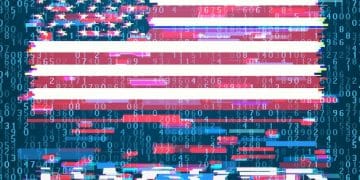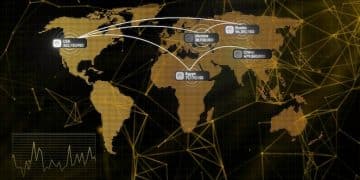Decoding US Sanctions: A Compliance Guide for 2025

Decoding the Latest US Sanctions: A Practical Guide for Compliance in 2025 offers a comprehensive overview of the evolving landscape of US sanctions, providing businesses and individuals with actionable strategies to navigate and comply with these regulations effectively.
Navigating the intricate web of **Decoding the Latest US Sanctions: A Practical Guide for Compliance in 2025** can be daunting, especially with the ever-changing geopolitical landscape. This guide offers a clear path to understanding and adhering to these regulations.
Understanding the Evolving Landscape of US Sanctions
US sanctions are a powerful tool of foreign policy, and their complexity is constantly evolving. Understanding the current landscape is crucial for any entity operating globally.
Sanctions can target entire countries, specific industries, or even individual people and organizations. The reasons behind these sanctions are varied and can range from counter-terrorism efforts to preventing nuclear proliferation. Keeping up with these changes is a continuous process.
Key Agencies Involved in US Sanctions
Several government agencies play vital roles in administering and enforcing US sanctions. Knowing which agencies oversee specific sanctions programs is essential for compliance.
- OFAC (Office of Foreign Assets Control): Administers and enforces economic and trade sanctions based on US foreign policy and national security goals.
- BIS (Bureau of Industry and Security): Regulates the export and re-export of sensitive goods and technologies.
- State Department: Plays a significant role in setting foreign policy objectives and implementing related sanctions.
These agencies work in concert to ensure that US sanctions are effective and aligned with the country’s strategic interests.

Staying informed about the latest updates from these agencies is a critical aspect of maintaining compliance. Regular monitoring of their websites and publications will help organizations adapt to changing regulations.
Key Changes in US Sanctions Policy for 2025
Sanctions policies are rarely static; they adapt to new global challenges and shifts in geopolitical power. Staying informed about the latest changes is critical.
Several factors can influence changes in US sanctions policy, including evolving threats, shifts in international relations, and advancements in technology. For 2025, some key areas demand attention.
Focus on Technology and Cyber Activities
With the increasing importance of technology, sanctions related to cyber activities and technology transfers have become more prevalent. Organizations must be vigilant about these areas.
- Cyber Sanctions: Targeting individuals and entities involved in malicious cyber activities.
- Technology Transfer Restrictions: Preventing the transfer of sensitive technologies to sanctioned countries or entities.
- Supply Chain Security: Ensuring that supply chains are not compromised by sanctioned parties.
The US government sees technology as vital to national security and is likely to continue using sanctions to protect its interests in this area.
Paying close attention to changes in these areas is essential for businesses operating in the technology sector and any organization dealing with technology transfers.
Developing a Robust Sanctions Compliance Program
A robust compliance program is the cornerstone of adherence to US sanctions regulations. This program should be tailored to the specific risks facing your organization.
Effective compliance programs don’t happen overnight; they require planning, implementation, and continuous improvement. The key is to build a program that is both comprehensive and adaptable.
Essential Elements of a Compliance Program
A well-designed sanctions compliance program should include several key components:
- Risk Assessment: Identifying and assessing the specific risks facing your organization.
- Policies and Procedures: Developing clear policies and procedures for compliance.
- Screening and Monitoring: Implementing robust screening and monitoring processes.
These elements work together to create a layered defense against sanctions violations.
Regular training for employees and ongoing monitoring are also vital to ensuring the effectiveness of a compliance program. Being proactive is always better than being reactive when it comes to compliance.

Conducting Due Diligence for Sanctions Compliance
Due diligence is a critical step in preventing sanctions violations. It involves thoroughly investigating the parties you are dealing with to ensure they are not sanctioned.
Robust due diligence goes beyond simply checking names against a list. It requires a deeper understanding of the entities you are working with and the risks they pose.
Key Steps in Conducting Due Diligence
A comprehensive due diligence process should include these steps:
- Screening: Screening parties against sanctions lists and databases.
- Ownership Research: Identifying the ultimate beneficial owners of entities.
- Transaction Monitoring: Monitoring transactions for potential red flags.
These steps help to identify and mitigate potential risks associated with sanctions violations.
Implementing ongoing due diligence procedures helps ensure that your organization remains compliant with US sanctions regulations. Remember, knowledge is power, and due diligence is a key source of that knowledge.
Navigating Complex Sanctions Scenarios
In the real world, sanctions compliance is rarely straightforward. Organizations often encounter complex scenarios that require careful analysis and decision-making.
These scenarios can involve intricate ownership structures, indirect relationships, and cross-border transactions. Understanding how to navigate these complexities is essential for compliance.
Common Complex Scenarios and Solutions
Here are some common scenarios and potential solutions:
- Indirect Ownership: Identifying and assessing the risks associated with indirect ownership structures. Solution: Conduct thorough ownership research to identify the ultimate beneficial owners.
- Transactions Involving Multiple Jurisdictions: Navigating sanctions regulations in multiple jurisdictions. Solution: Seek legal advice and conduct thorough due diligence on all parties involved.
- Dealing with Designated Persons: Understanding the restrictions on dealing with designated persons. Solution: Implement strict screening and monitoring procedures to identify and avoid transactions with designated persons.
By understanding these scenarios and developing effective solutions, organizations can better navigate the complexities of sanctions compliance.
When faced with a complex scenario, don’t hesitate to seek expert advice. It’s better to be cautious and make sure you’re in compliance than to risk a violation.
The Role of Technology in Sanctions Compliance
Technology plays an increasingly important role in sanctions compliance. It can help organizations automate processes, improve accuracy, and enhance their overall compliance efforts.
From screening tools to transaction monitoring systems, technology offers a range of solutions for managing sanctions risks. However, technology is not a silver bullet; it must be integrated into a well-designed compliance program.
Technology Solutions for Sanctions Compliance
Here are some technology solutions that can help with sanctions compliance:
- Screening Tools: Automating the screening of parties against sanctions lists.
- Transaction Monitoring Systems: Monitoring transactions for potential red flags.
- Data Analytics: Analyzing data to identify patterns and trends that may indicate sanctions violations.
These tools can significantly improve the efficiency and effectiveness of sanctions compliance efforts.
Investing in the right technology can help your organization stay ahead of the curve and maintain compliance with US sanctions regulations. But remember, technology is only as good as the people who use it.
| Key Point | Brief Description |
|---|---|
| ⚠️ Evolving Landscape | US sanctions constantly evolve due to geopolitical shifts and emerging threats. |
| 🛡️ Compliance Program | A robust program requires risk assessment, policies, and employee training for effectiveness. |
| 🔍 Due Diligence | Crucial to prevent sanctions violations; involves screening, ownership research, and monitoring. |
| 🤖 Role of Tech | Technology solutions enhance compliance via automated screening and data analytics. |
Frequently Asked Questions
▼
US sanctions are economic and trade restrictions implemented by the US government to achieve foreign policy and national security objectives, targeting specific countries, entities, or individuals.
▼
US sanctions apply to US citizens and entities, as well as any foreign individuals or entities conducting business within US jurisdiction or using US-origin goods or services.
▼
Penalties for violating US sanctions can include significant fines, imprisonment, and the revocation of export licenses, depending on the severity and nature of the violation.
▼
To ensure compliance, implement a robust sanctions compliance program that includes risk assessment, screening, monitoring, training, and due diligence processes tailored to your business.
▼
Official sources like the OFAC website, BIS website, and legal advisories provide the most reliable and current information on US sanctions updates and regulatory changes.
Conclusion
Navigating the complexities of US sanctions requires a proactive and informed approach. By understanding the landscape, implementing a robust compliance program, and staying up-to-date on the latest changes, organizations can effectively mitigate the risks and complexities of US sanctions compliance in 2025 and beyond.





